🍏 The History of Green Apple-Flavored Candy 🍏
Craving something sweet? Jump to my favorite 5 green apple-flavored candies!
Candy, with its diverse array of flavors and forms, has an enchanting ability to evoke joy and nostalgia in people of all ages. Among the plethora of candy flavors, the tangy and vibrant taste of green apple holds a special place. The history of green apple-flavored candy is a captivating tale of culinary creativity, cultural influences, and the enduring appeal of this iconic fruit. Let's embark on a journey through time to explore the fascinating history of green apple-flavored candy, from its early origins to its modern-day popularity. Here we go!
🍏 Early Culinary Explorations 🍏
The use of apples in confectionery dates back centuries to various ancient cultures. Apples were often preserved with honey, molasses, or sugar to create candied apples or apple-based confections. These early apple candies were simple, sweet treats enjoyed for their natural flavor and the preservation of seasonal fruit.
As sugar production and refinement techniques improved over time, confectioners gained greater control over the flavors and textures of their sweets. Apples, being one of the most widely cultivated and appreciated fruits, naturally found their way into the growing world of confectionery.
🍏 The Renaissance: Advancements in Sugarcraft 🍏
The Renaissance period in Europe marked a significant turning point in the history of green apple-flavored candy. The burgeoning sugar trade and advancements in sugarcraft allowed confectioners to create a wide range of innovative sweets, including fruit-flavored candies. During this time, apples, including green apples, were commonly used as a base for various confections.
One notable development was the creation of apple-shaped candies. Confectioners crafted apple-shaped hard candies, often with a bright green hue and a sugary exterior. These candies, sometimes known as "apple drops," offered a delightful combination of sweetness and a hint of tartness. The apple shape not only added visual appeal but also made them a favorite choice for festive occasions.
🍏 The 18th Century: Evolution of Apple-Flavored Candies 🍏
The 18th century witnessed the evolution of apple-flavored candies, as confectioners experimented with new techniques and flavor profiles. Apple essences and extracts were developed, allowing for the creation of more authentic apple-flavored sweets. These innovations paved the way for the emergence of green apple-flavored candy as a distinct category.
One notable apple-flavored candy that gained popularity during this time was the apple-flavored taffy. Taffy, known for its chewy texture and versatility, offered a delightful way to capture the essence of green apples. The taffy-making process involved stretching and pulling, which incorporated air and created a lighter, more enjoyable candy. Green apple taffy became a beloved treat, often enjoyed at fairs and festivals.
🍏 The 19th Century: Candy Innovations and Mass Production 🍏
The 19th century marked a period of significant candy innovation and mass production. The industrial revolution led to the mechanization of candy-making processes, making candy more accessible to a broader audience.
Green apple-flavored candies, including hard candies and taffies, became widely available as a result of these advancements. Confectioners utilized artificial colorings and flavorings to create candies that mimicked the vibrant green color and tartness of green apples. These candies were packaged in colorful wrappers and sold in stores, delighting candy enthusiasts of all ages.
🍏 The Mid-20th Century: Green Apple Candy Boom 🍏
The mid-20th century brought about a boom in the production and consumption of green apple-flavored candy. This period was characterized by post-World War II economic prosperity and a growing interest in unique and exotic flavors.
One iconic green apple-flavored candy that emerged during this era was the Green Apple Jolly Rancher. Jolly Rancher, a brand known for its hard candies and bold fruit flavors, introduced the green apple flavor to its lineup. The Green Apple Jolly Rancher quickly gained popularity for its vibrant tartness and became a staple in candy shops and supermarkets.
Another significant development during this time was the creation of green apple-flavored lollipops. These lollipops, with their bright green color and intense apple taste, became a favorite among children and adults alike. The convenience of a lollipop made it a popular choice for on-the-go snacking and a symbol of sweet nostalgia.
🍏 Modern-Day Green Apple Candy 🍏
In the contemporary candy landscape, green apple-flavored candy remains a beloved classic. Its versatility is evident in the wide range of green apple-flavored confections available today, from gummies and jellybeans to gum and flavored popcorn.
One notable trend in modern green apple-flavored candy is the fusion of green apple with other flavors to create innovative and exciting taste experiences. For example, green apple and caramel combinations offer a delightful blend of tartness and sweetness, evoking the flavors of a classic caramel apple.
🍏 The Role of Green Apple Candy in Popular Culture 🍏
Green apple-flavored candy, with its vibrant tartness and distinct flavor, has made its mark on popular culture. Its bold color and unique taste evoke a sense of excitement and adventure. Green apple candies often appear in literature, film, and television as symbols of energy and creativity.
One notable example is the use of green apple candy in literature and film as a representation of temptation and indulgence. The bright green color and alluring flavor create a sense of desire and allure that adds depth to the narrative.
Green apple-flavored candies are also featured in celebrations and traditions. They are often incorporated into Halloween-themed candies, adding a touch of tangy tartness to the festivities. Green apple-flavored candies are also enjoyed during St. Patrick's Day celebrations, fitting perfectly with the holiday's green theme.
The history of green apple-flavored candy is a delightful journey through time, reflecting the evolution of taste preferences, culinary creativity, and cultural influences. From its early roots in simple candied apples to its contemporary presence in an array of confections, green apple-flavored candy has captured the hearts and taste buds of generations. Its tartness, bold color, and versatility make it a beloved choice in the world of candy. As we savor a piece of green apple-flavored candy, we can appreciate the rich history and cultural significance that have made this iconic flavor a timeless favorite—a symbol of tart delight and the sweet pleasures of life.
🍏 Green Apple Candy Recommendations 🍏
Here are some links to my favorite green apple flavored candies!
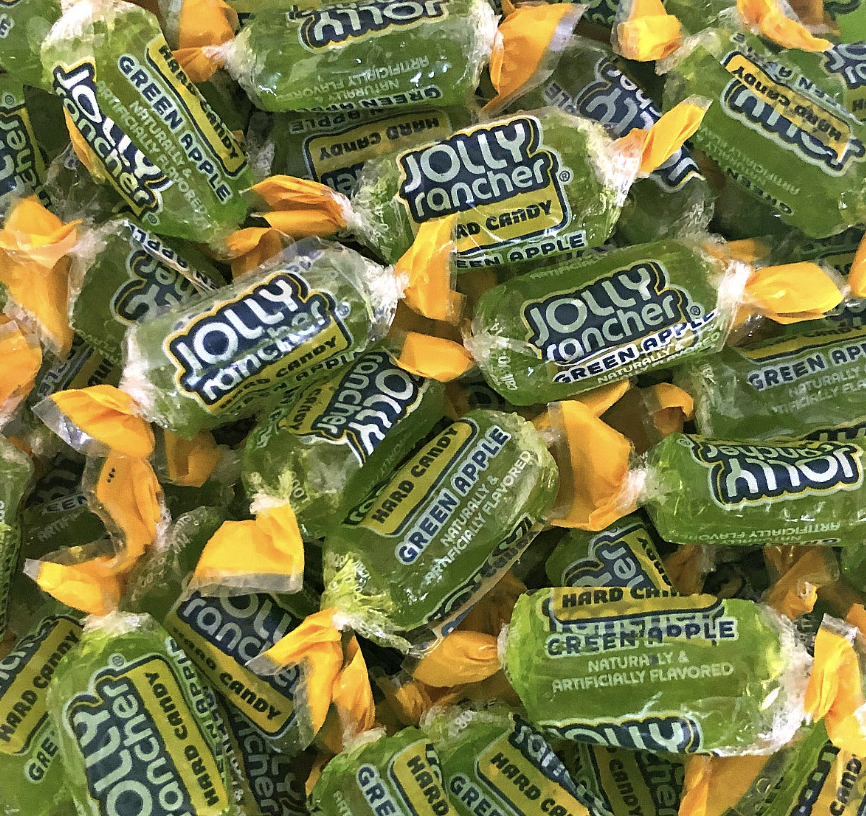
• Green Apple Jolly Ranchers (Amazon) : an enduring classic, Green Apple Jolly Ranchers also happen to go pretty well with Watermelon Jolly Ranchers, my favorite hard candy of all time!
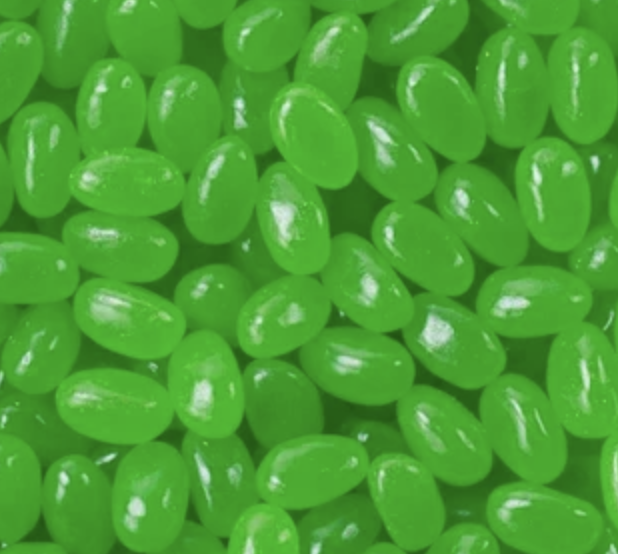
• Green Apple Jelly Belly Jelly Beans (Amazon): once again, Jelly Belly packs their jelly beans with juicy fruit flavor. Love the bright green color of this flavor, too!
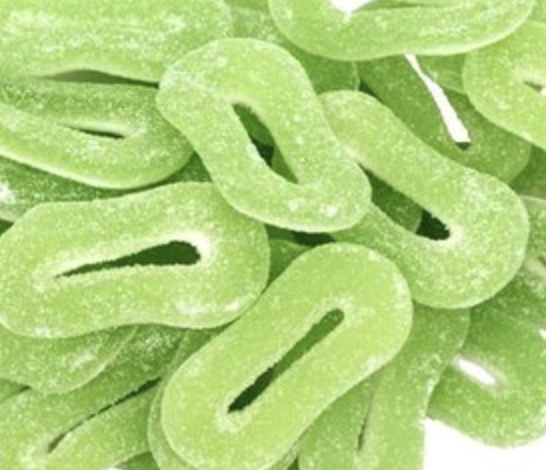
• Haribo Sour Apple Rings aka Saure Apfelringe (Amazon): these are a little squishier than other sour apple gummy rings on the market, but what they lack in aesthetics, they absolutely make up for in tart green apple flavor!
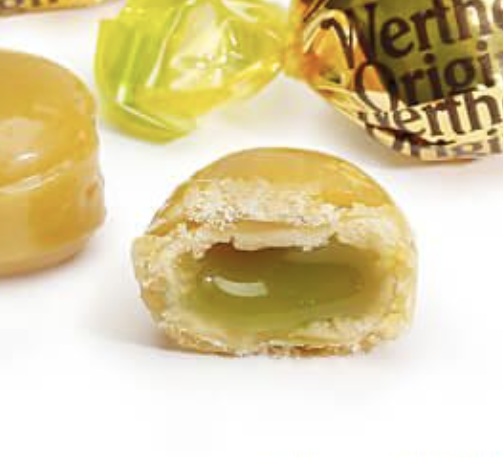
• Werther's Caramel Apple Filled Hard Candies (Amazon): my inner 65-year-old loves Werther's Originals AND more novel Werther's flavors like this luscious mix of apple and caramel flavor.
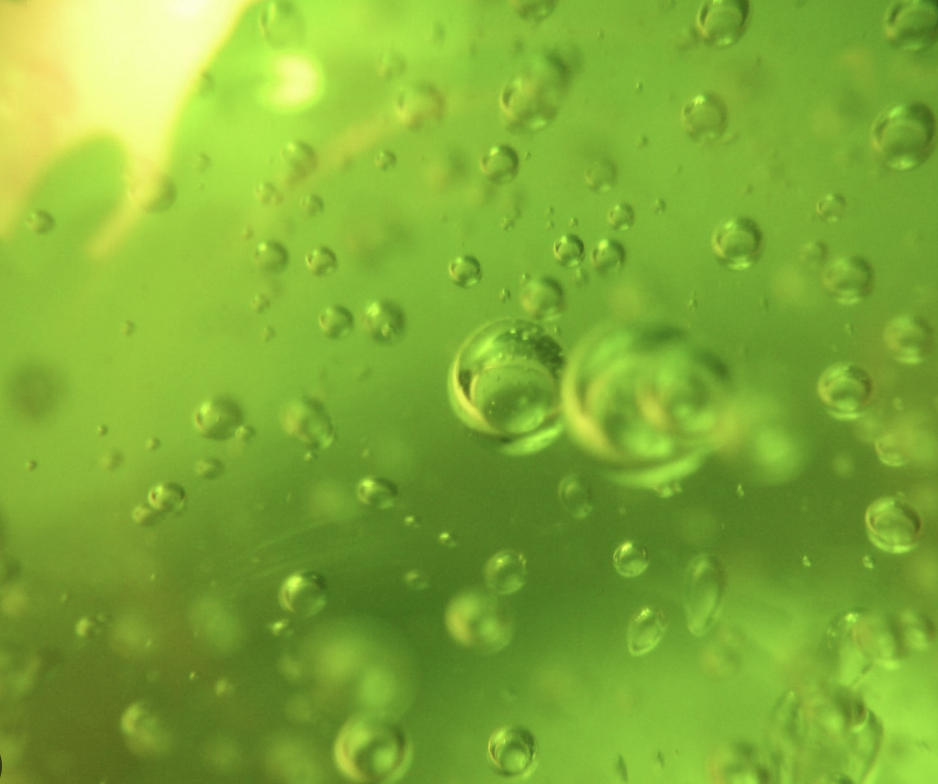
• Slime Licker Sour Apple Gel Candy (Amazon): meanwhile, my inner 12-year-old still can't get enough of gooey gel candy. Something about sour green apple flavor just goes so well with viscous slime candy. We used to eat slime in the 90s! And we still can!!!
🚨 BONUS ARTICLE! 🚨
🍎 The History of Red Apple-Flavored Candy 🍎
Craving something sweet? Jump to my red apple candy recommendations!
Candy, with its endless variety of flavors and textures, has an enchanting ability to evoke fond memories and delight people of all ages. Among the diverse array of candy flavors, the sweet and comforting taste of red apple holds a special place. The history of red apple-flavored candy is a captivating journey through time, filled with culinary innovation, cultural influences, and the enduring appeal of this iconic fruit. Let's embark on a 1000-year exploration to unravel the intriguing history of red apple-flavored candy, from its ancient roots to its modern-day popularity. Here we go!
🍎 Ancient Origins: Apples as Sweet Treasures 🍎
The use of apples in confectionery dates back to ancient civilizations, where these fruits were highly regarded for their natural sweetness. Apples were a cherished treat, often preserved in honey or syrup to create candied apples or apple-based confections. These early apple candies were simple, sweet indulgences enjoyed for their inherent flavor and the preservation of seasonal fruit.
As sugar production and refinement techniques improved over time, confectioners gained greater control over the flavors and textures of their sweets. Apples, including red apples, became a common ingredient in the growing world of confectionery.
🍎 The Renaissance: Culinary Advancements and Apple Confections 🍎
The Renaissance period in Europe marked a significant turning point in the history of red apple-flavored candy. The increasing sugar trade and advancements in sugarcraft allowed confectioners to create a wide range of innovative sweets, including fruit-flavored candies. Apples, with their widespread cultivation and popularity, naturally found their way into the expanding world of confectionery.
One notable development during this period was the creation of apple-shaped candies. Confectioners crafted apple-shaped hard candies, often with a red hue and a sugary exterior. These candies, sometimes known as "apple drops," were not only visually appealing but also offered a delightful combination of sweetness and a hint of tartness. The apple shape added a playful touch, making them particularly popular during festive occasions.
🍎 The 18th Century: Evolution of Apple-Flavored Candies 🍎
The 18th century witnessed the evolution of apple-flavored candies, as confectioners experimented with new techniques and flavor profiles. Apple essences and extracts were developed, enabling the creation of more authentic apple-flavored sweets. These innovations laid the foundation for the emergence of red apple-flavored candy as a distinct category.
One notable apple-flavored candy that gained popularity during this time was the apple taffy. Taffy, known for its chewy texture and adaptability to various flavors, offered a delightful way to capture the essence of red apples. The taffy-making process involved stretching and pulling, which incorporated air and created a lighter, more enjoyable candy. Red apple taffy quickly became a beloved treat, often enjoyed at fairs and festivals.
🍎 The 19th Century: Candy Innovations and Mass Production 🍎
The 19th century marked a period of significant innovation in confectionery, driven by advancements in sugar production and candy-making techniques. Industrialization led to the mechanization of candy production, making candy more accessible to a broader audience.
Red apple-flavored candies, including hard candies and taffies, became widely available during this period. Confectioners used artificial colorings and flavorings to create candies that mimicked the vibrant red color and the sweet taste of red apples. These candies were often packaged in colorful wrappers and sold in stores, delighting candy enthusiasts of all ages.
🍎 The Mid-20th Century: Red Apple Candy Boom 🍎
The mid-20th century saw a surge in the production and consumption of red apple-flavored candy. This period was marked by post-World War II economic prosperity and a growing interest in unique and nostalgic flavors.
One iconic red apple-flavored candy that emerged during this era was the Red Apple Jolly Rancher. Jolly Rancher, a brand known for its hard candies and bold fruit flavors, introduced the red apple flavor to its lineup. The Red Apple Jolly Rancher quickly gained popularity for its vibrant sweetness and became a staple in candy shops and supermarkets.
Another significant development during this time was the creation of red apple-flavored lollipops. These lollipops, often featuring a bright red color and a sweet apple taste, became a favorite among children and adults alike. The convenience of a lollipop made it a popular choice for on-the-go snacking and a symbol of sweet nostalgia.
🍎 Modern-Day Red Apple Candy 🍎
In the contemporary candy landscape, red apple-flavored candy remains a cherished classic. Its versatility is evident in the wide range of red apple-flavored confections available today, from gummies and jellybeans to gum and flavored popcorn.
One notable trend in modern red apple-flavored candy is the fusion of red apple with other flavors to create innovative and exciting taste experiences. For example, red apple and caramel combinations offer a delightful blend of sweetness and richness, reminiscent of classic caramel apples.
🍎 The Role of Red Apple Candy in Popular Culture 🍎
Red apple-flavored candy, with its sweet and comforting taste, has left a mark on popular culture. Classic red apple confections and pastries often appear in literature, film, and television as symbols of comfort and joy.
One notable example is the use of red apple candy in literature and film as a representation of innocence and the simple pleasures of life. The bright red color and the sweetness of red apples create a sense of simplicity and wholesomeness that resonates with audiences.
The history of red apple flavor is a delightful journey through time, reflecting the evolution of taste preferences, culinary creativity, and cultural influences. From its early origins in simple candied apples to its contemporary presence in a wide array of confections, red apple-flavored candy has captured the hearts and palates of generations.
🍎 Red Apple Candy Recommendations 🍎
Long overshadowed by the enduring popularity of green apple flavors, red apple flavors are finally coming into their own! Here are some links to my favorite red apple candies:
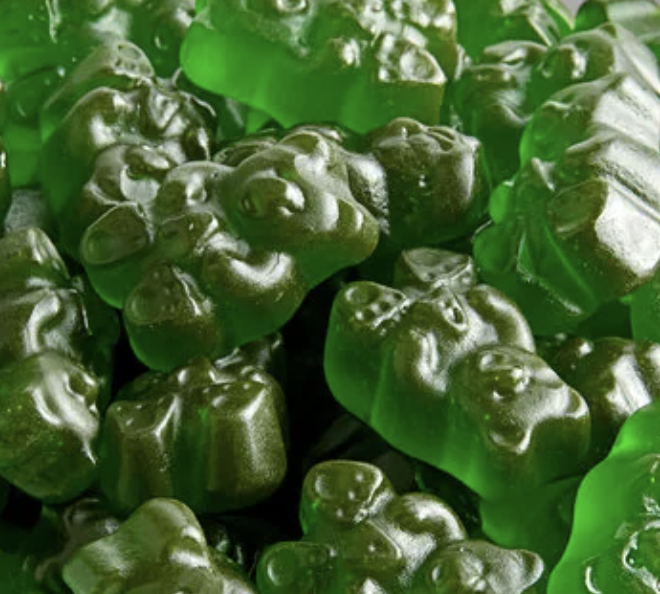
• Apple Crisp Flavored Gummy Bears by Kaufmann (Amazon): honestly I wasn't expecting to enjoy chewy gummies flavored like a famously crispy dessert, but I was pleasantly surprised by the rich flavor of these hunter green bears!
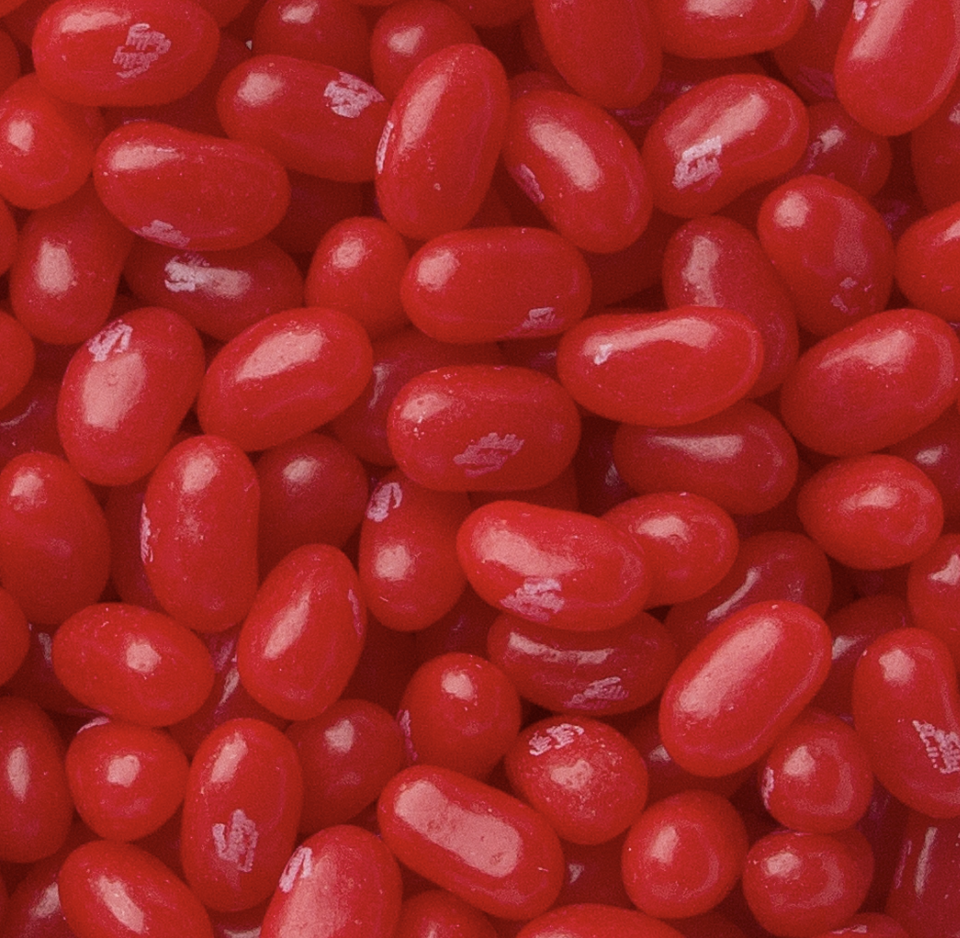
• Apple Cider Jelly Belly Jelly Beans (Amazon): a lightly spicy, cinnamony mix of Jelly Belly flavors.
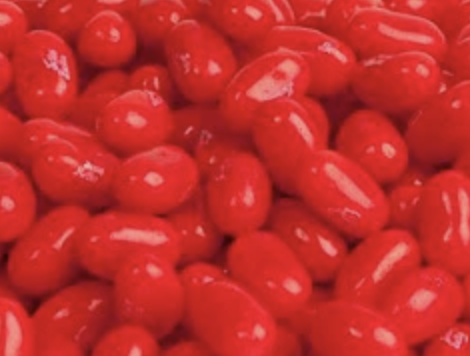
• Red Apple Jelly Belly Jelly Beans (Amazon): I'm always happy to see red apple flavor on the same plane as green apple flavor! Green apple may be one of Jelly Belly's classic flavors, but I have to say, red apple has become one of my favorite Jelly Belly flavors.
